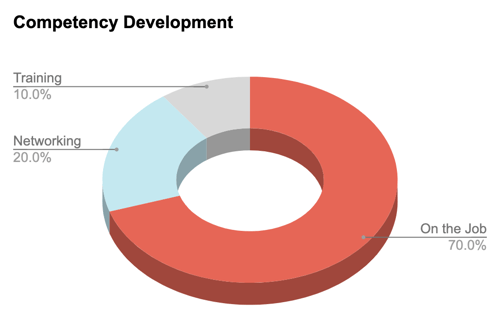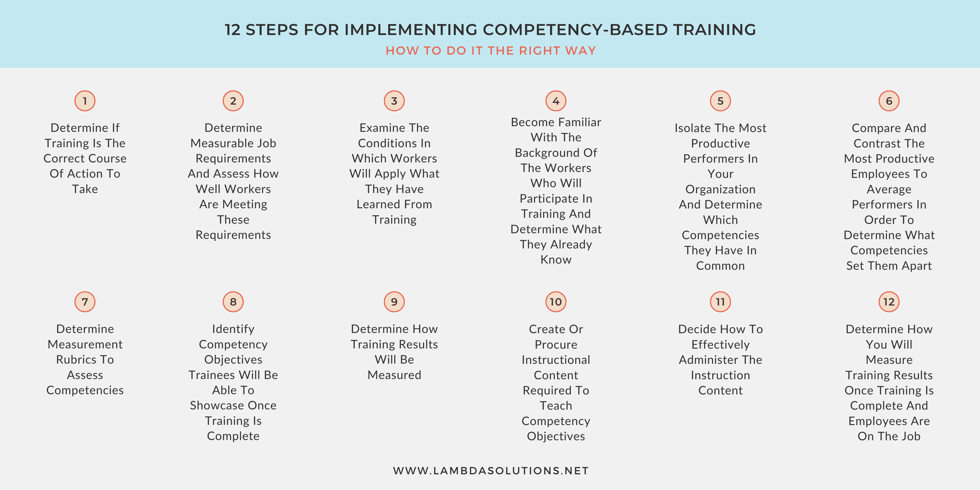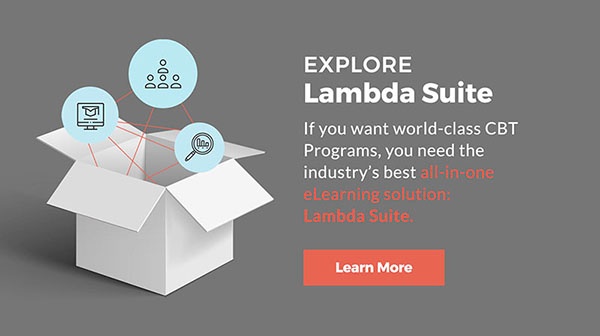Competency Based Training (CBT) is a concept that has been around for decades, but it has only recently gained mainstream attention for both its effectiveness and ability to create competitive advantage through human talent.
Many organizations claim to have fully implemented competency-based training models, but the reality is that few do it successfully. In this article, we’ll explore what you need to know to create a successful CBT program, develop talent, and exceed organizational targets.
In this article you’ll find:
Competency-Based Training (CBT): What It Is And Why You Should Consider It For Your Organization
Developing and maintaining a fully functioning competency-based training (CBT) program requires significant time and resources. It truly takes years for a dedicated team of Human Resources and Learning and Development managers to create and deploy organization-wide competency-based training. But why does that happen? And what exactly is CBT?
What Is Competency-Based Training?
Before we define and explain competency-based training (CBT), let’s break it down to define ‘competency’.
Competencies meaning the term referring to individual characteristics that contribute to acceptable or outstanding performance. Competencies can be anything from a set of knowledge, skills, behaviours, attitudes, and characteristics that lead to producing distinguished results[1].
Competencies lie at the core of successful performers so it is important to understand that the analysis of high-achieving talent is one way to identify competencies that allow success over others[1].
Breaking it down further, there are different categories of competencies such as functional competencies, personal competencies, and business competencies. Functional competencies are applicable technical knowledge or skills that are needed for a particular field or profession[2]. For example, accountants require different functional competencies than engineers or electricians.
The second group of competencies is personal competencies, which are individual attitudes and skills required to maintain professional relationships and personally develop and learn. An example of a personal competency would be one’s communication skills or the ability to prioritize commitments.
The final group of competencies is business competencies wherein individuals have the ability to view problems or situations through a business lens; for example, strategic or critical financial thinking[2].

What is competency-based training then? According to the National Skills Center of Australia, “competency-based training is a structured approach to training and assessment that is directed toward achieving specific outcomes. It is about assisting individuals to acquire skills and knowledge so they are able to perform a task to a specified standard under certain conditions”.
Thus, in competency-based training, a performer’s expected outcomes must be clearly stated so that the learner knows exactly what is expected of them. Similarly for competency-based trainers and educators, once competencies are assigned to learners, the trainer will know the precise training and education that is required to bring the learner to the desired level of competency[3].
Bringing the aforementioned all together, the organizational aim is then to create core competency models for specific functional roles that contribute to company-wide strategic goals. Competency models are a set of typically 10-30 competencies that define the capabilities of the best performers[1]. To derive competency models it is key to focus on performers who have been highly successful in the roles for which competency models are created.
To do this, create profiles of exemplary performers and be sure to define their effectiveness based on measurable abilities and traits. Once competency models are created it is then easier to identify gaps in your talents’ behavioural or work outputs. Being able to identify these gaps is the first step in bringing talent to a level of competency that creates competitive advantage[1].

Why More Organizations Are Focusing On Competency-Based Training
More and more organizations are implementing competency-based training because it helps to prioritize training dollars and ultimately it achieves results[3].
Research tells us that some individuals are up to 20 times more productive than others. If you could have your pick of these hyper-productive employees, wouldn’t you? Lucky for you, with competency-based training you can. When you match both individual competencies with job competency models you effectively put talent in positions where they will flourish[1].
Coupled with this, by simultaneously focusing on developing the employee’s competencies, you will come closer to closing the gap to the competency model so that the employee reaches his or her ultimate potential. When this happens the individual will have reached a level of self-actualization wherein benefit to the company continues to multiply.
Here are even more reasons why organizations use competency-based training:
Competitive advantage is achieved for organizations that know the characteristics that drive the best results because they are better positioned to recruit, select, develop, reward, and promote their best talent[1].
According to training experts, Graber & Rothwell, “competencies are an important tool, much like a compass, to find direction in attracting, developing, retaining, and positioning the best, most productive and promotable people.”
Competencies Outlive Job Tasks
Since competencies are built around the characteristics of highly successful people, they outlive job descriptions and can be used by organizations to train and evaluate talent forever [1]. There will, of course, be times when competencies can be modified and added upon but their essence will remain virtually unchanged. Compared to job descriptions, competencies effectively center in on the particular characteristics of individuals that lead to success above their peers. Often, the unique characteristics that competency evaluations highlight are overlooked or ill-identified in job descriptions.
Competencies Support Organizational Capabilities
As we all know successful organizations have strategic capabilities that set them apart from their competition. This relates to competencies because, collectively, in order for an organization to excel at capabilities like innovation, low cost, and service—they need to possess certain competencies to thrive in these areas[1]. For example, if an organization’s strategy is to be a low-cost provider (e.g. Walmart), they will need to focus hiring efforts on competencies much different than an organization focused on exceptional service (e.g. Nordstrom).
4 Reasons Why Learning And Development (L&D) Managers Love CBT
1. Competencies Target The Foundation
Competencies are often ingrained characteristics or traits that are built up over years of experience and training. Learning and Development (L&D) managers find that their best talent don’t even realize they have them—those traits are so ingrained that they become second nature in one’s behaviour and attitude.
Thus, in order to understand successful performers at their core, Learning and Development managers have to spend significant time observing and probing these individuals to truly understand how they developed their core competencies over time.
It has been found that most peak performers have attained their competencies through proactive measures such as: coaching and mentoring, networking, observing other top performers, joining problem-solving groups and communities of practice, and reading[1]. Aside from on the job training, Learning and Development managers can provide the aforementioned activities to further develop employee competencies.
2. The 70-20-10 Percent Competency Development Rule
The 70-20-10 percent competency rule suggests that 70% of competencies development happens on the job, 20% happens through networking either online or in person, and only 10% happens through programmed training[1]. For example, if seeking to improve an individual’s emotional intelligence competency, training is a small portion of the development path.
The majority of the development plan is best spent working closely on a project with an employee or supervisor who demonstrates high emotional intelligence. By carefully observing the emotionally intelligent co-worker, the trainee can then set aside time for one-on-one conversations to delve deep insight into his or her observed subject’s cognitive and emotional process to gain further understanding.

3. Competencies Define Organizational HR Needs To Achieve Strategic Outcomes
When companies have complete competencies, meaning organization-wide competency assessments, they are able to identify core competency gaps that impede short and long-term strategic results. Once competency gaps are identified, Human Resources (HR) professionals are positioned to make better decisions when it comes to recruitment, hiring, onboarding, performance management, compensation planning, and succession planning.
Structuring a successful L&D program can be challenging and requires understanding human comprehension. Check out our article: 3 Core Competencies Your HR Must Have For Successful L&D
4. Competencies Provide Employees With Linear Or Non-linear Advancement Plans
When employees have a deep understanding of their strengths and weaknesses—the competencies where they are lag or excel—they are better able to focus their development efforts to improve their shortcomings. In future articles, we’ll discuss various methods to help employees gain insight into their competencies and areas for improvement.
Once competency assessments are completed, managers are also equipped with extensive insight to discuss career paths and development plans so employees can advance in their careers and reach their highest potential.
Benefits Of Competency Modeling
Significant time and effort go into creating accurate and whole competency models. When done properly, organizations will benefit from the following[1]:
- Lower turnover due to high productivity and employee value alignment
- Ability to identify training gaps allowing for targeted training
- Facilitation of employee development through tailored individual development plans
- Creation of career paths for future positions
- Quicker and easier to the identification of candidates ready for promotion
- Development of workforce plans that meet future talent needs
- Competency-focused succession plans
Creating a succession plan for your business? Check out our article: 7 Easy Steps for Business Succession Planning Success.
Deciding to Develop a CBT program will not guarantee you success. Competency-based learning is a lot of work to get off the ground, and can be a huge waste of effort if things don’t go well. To help you avoid some of the work and all of the heartbreak, our implementation experts put together these dozen steps for you to follow for a world-class CBT training program.
12 Steps For Implementing Competency-Based Training
These 12 steps for implementing competency-based training will help you, among other things, determine measurable job requirements, examine the conditions in which the outcomes from CBT will be applied, and set specifications for measuring training results.
Implementing Competency-Based Training: How To Do It The Right Way
Before diving in, it is important to first understand the concept of competency-based learning from the perspective of an employee.
As a Learning and Development manager, any efforts you make to provide enriching learning experiences will undoubtedly go to waste if the learner is not willing to take responsibility for their learning.
Employing proactive learners will ensure that your talent seeks out people or experiences that will help them remain ahead of the curve for career advancement and promotion. Competency-based learning is thus the actions that individuals take to support their continued Learning and Development.
Such actions may include learning from exemplary performers and enrolling in certification programs. Competency-based training thus differs in the sense that it is initiated by organizations to help talent match profiles of highly-successful workers and develop greater competence in employees[1].

Continue reading for the details of each step!
Here is how to implement CBT in 12 steps:
Step 1. Determine If Training Is The Correct Course Of Action To Take
Ask yourself if the performance problem can be solved by training or if it requires other managerial actions. Here are a few questions that will help to determine if training will resolve the performance problem:
- Does the performance problem stem from the individual’s shortcomings in knowledge, skill, or attitude? If yes, then continue to step 2.
- Does the performance problem require Management action such as:
- Changing/modifying job descriptions or work requirements to align with departmental and organization needs
- Changing performance review criteria to better suit the competencies of the position.
- Changing tools or equipment provided to workers
- Changing or modifying reward or pay systems
If you select any of the changes that require managerial action above, training will not likely solve performance issues.
Step 2. Determine Measurable Job Requirements And Assess How Well Workers Are Meeting These Requirements
Steps 2-5 are geared towards analyzing your training needs so that you are on the right track from the get go. In step 2 it is important to ask yourself the following questions to determine training requirements:
- Who are you targeting to receive the training (is it a particular group or employee)?
- What must this group or employee accomplish?
- In what setting or under what working conditions will they perform?
- How will training be accessed once completed and whom will complete the assessment?
Step 3. Examine The Conditions In Which Workers Will Apply What They Have Learned From Training
Here it is important that your trainees have real-life situations to apply what they have learned in training. The best results for learning retention are those where employees have a minimum of three different scenarios to apply a single learned competency.

Step 4. Become Familiar With The Background Of The Workers Who Will Participate In Training And Determine What They Already Know
In some competency training scenarios, you will not benefit from years of experience working with the trainee. For example, when completing employee onboarding training, your only experience of getting to know the employee’s background will be through the interview process.
Thus, in scenarios with little understanding of the trainee’s talent, it is best to administer a probing survey to discover the current level of competency for which you are seeking to improve.
Step 5. Isolate The Most Productive Performers In Your Organization And Determine Which Competencies They Have In Common
Once these competencies are determined, ensure that they are applicable to the position(s) for which you are administering training.
In this step, it is important to isolate measurable performance indicators that have been objectively measured. Typically, Senior HR directors are best suited to objectively isolate the most productive employees but some competency experts believe that job incumbents may be better judges of this if objective performance measures are not available.
Step 6. Compare And Contrast The Most Productive Employees To Average Performers In Order To Determine What Competencies Set Them Apart
The following are questions that will help compare top versus average performers:
- What makes the top performers different from the acceptable performers?
- What individual strengths do they have that average performers do not?
- What processes do they use to complete work as effectively as they do?
- Are there any differences in their knowledge base? For example, does the superior performer have unique talent with mathematics?

Step 7. Determine Measurement Rubrics To Assess Competencies
Here it is wise to think about whether you want to use behavioural rubrics, or even skill tests and certification. Another consideration is if it would be beneficial to measure work output along with the quality of work.
For example, can Sally produce 3 research papers that address innovative ideas?
Step 8. Identify Competency Objectives Trainees Will Be Able To Showcase Once Training Is Complete
Here it is important that objectives are clearly outlined in competency-based terms. For example, knowledge and performance objectives should outline the specific results that the competency training will yield and how these results will be measured.
E.g. Sally will be able to effectively probe prospective clients within 2 minutes of a sales call to determine whether or not the prospect is a viable lead.
Step 9. Determine How Training Results Will Be Measured
How will you know whether learners were able to apply what they learned to improve their job performance?

Step 10. Create Or Procure Instructional Content Required To Teach Competency Objectives
Since this is an entire process on its own, Learning and Development managers often outsource this step to consultants who design instructional content.
Step 11. Decide How To Effectively Administer The Instruction Content
For example, will the trainee(s) learn the competencies best through a traditional classroom setting, on the job training, mentoring, online learning, or job shadowing?
Step 12. Determine How You Will Measure Training Results Once Training Is Complete And Employees Are On The Job
Remember the rule of three discussed in step 3.

Final Word
Here are a few additional methods for competency learning:
- Providing relevant articles and/or books
- Best practices or other exemplary knowledge in internal databases
- External websites and relevant documents or reports
- Watching videos and listening audio files or podcasts
- Coaching or mentoring either internally or externally
- Watching and mirroring successful performers
- Participating in centers of excellence (otherwise known as competency centers or capability centers)
For more advice, best-practices, and how-to guides to creating, implementing, and improving your Learning and Development programs, we have all of these additional resources:
- eBook: Big Data for HR: How Predictive Analytics Can Deliver Business Value
- eBook: Compliance and Competency Training Made Easy with LMS
- Case Study: Reduce Admin Time and Provide More Effective and In-demand Resources to HR Professionals
- Article: The Guide To Triaging Your L&D Budget Bleed
- Webinar: Why You Should Be Running Your L&D Team Like A Startup
- Webinar: Faster, Better, Easier User Management With Totara HR Import
- Webinar: How to Make Compliance Simple Yet Effective
References:
[1] William J. Rothwell and Jim M. Graber, Competency-Based Training Basics (New York: ASTD, 2010)
[2] http://learningdesigns.com/is-it-or-isnt-it-competency-based-training/
[3] https://www.k4health.org/sites/default/files/Guide to Writing Competency Based Training Materials.pdf







